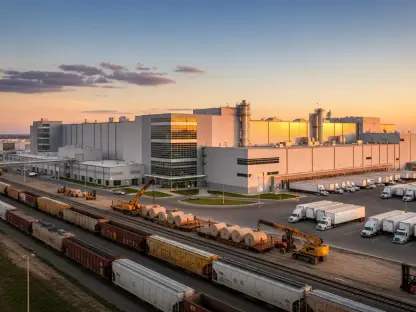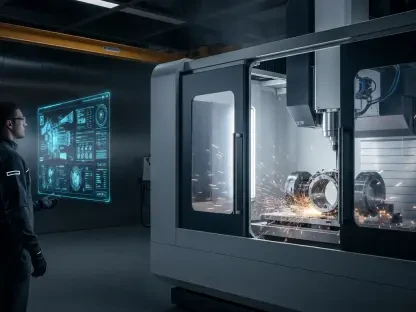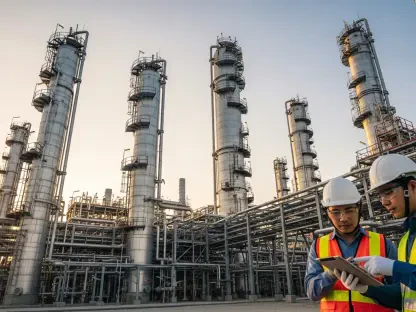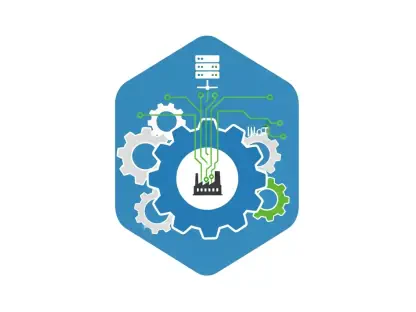The fusion of Artificial Intelligence (AI) and the Internet of Things (IoT), commonly known as AIoT, is revolutionizing the manufacturing industry. Coupled with the advanced capabilities of predictive maintenance, these technologies are setting new standards for operational efficiency, cost reduction, and overall productivity. This article dives into the transformative potential of AIoT and predictive maintenance, exploring how they are shaping the future of manufacturing.
The Synergy Between AI and IoT in Manufacturing
Enhancing Operational Efficiency
AIoT merges the data collection and connectivity strengths of IoT with the analytical power of AI. In manufacturing, this synergy results in smarter factory operations. Sensors embedded in machinery collect real-time data, which AI algorithms analyze to optimize various processes. This continuous feedback loop enhances operational efficiency by identifying bottlenecks, predicting maintenance needs, and streamlining production workflows. The integration of these technologies enables factories to move from reactive to proactive maintenance strategies, thereby significantly reducing downtime and improving productivity.
The real-time data collected from IoT sensors also feeds into AI systems that monitor and control energy usage, machine performance, and production quality. This dynamic interaction ensures that every aspect of manufacturing is continually assessed and optimized. Consequently, factories can operate at peak efficiency, reducing waste and minimizing energy consumption. This is particularly important for industries where margins are tight, and any inefficiency directly impacts profitability. The combined power of AI and IoT thus represents a seismic shift in how manufacturing processes are managed and optimized.
Real-Time Decision Making
One of the standout benefits of AIoT in manufacturing is the ability to make real-time decisions. By processing vast amounts of data quickly, AIoT systems can respond to changes in the manufacturing environment almost instantaneously. Whether adjusting machine settings for optimal performance or switching production lines to meet demand, real-time decision-making ensures manufacturing processes are agile and responsive. This capability is vital in an industry where time is money and the slightest delay can lead to significant financial losses.
Real-time decision-making enabled by AIoT also extends to predictive analytics, which can forecast demand trends and adjust production schedules accordingly. This predictive capability helps manufacturers avoid overproduction or underproduction, optimizing inventory levels and reducing storage costs. Moreover, AIoT systems can detect anomalies and potential issues before they escalate, allowing for immediate intervention. This proactive approach not only prevents downtime but also ensures the consistent quality of manufactured products, further enhancing customer satisfaction and brand reputation.
Predictive Maintenance: A Game-Changer
The Basics of Predictive Maintenance
Predictive maintenance leverages AI and machine learning to foresee equipment failures before they occur. It relies on continuous monitoring and data analysis to predict when a piece of machinery will require maintenance. This proactive approach minimizes unexpected downtimes, reduces repair costs, and extends the lifespan of equipment. Unlike traditional maintenance methods, which are either reactive or scheduled at regular intervals, predictive maintenance is data-driven and condition-based, ensuring that maintenance actions are performed only when necessary.
The continuous monitoring aspect of predictive maintenance involves collecting data from various sensors attached to equipment. These sensors measure parameters like temperature, vibration, and pressure, which are then analyzed by AI algorithms. By identifying patterns and anomalies in the data, these algorithms can accurately predict equipment failures. This allows maintenance teams to act swiftly, addressing issues before they result in unplanned shutdowns. The result is a significant boost in operational efficiency and a reduction in maintenance-related costs.
Reducing Operational Costs
AI-driven predictive maintenance can significantly reduce operational costs. By predicting failures and addressing them beforehand, manufacturers avoid costly emergency repairs and the downtime associated with unexpected machine breakdowns. Scheduled maintenance can be conducted during non-peak hours, further minimizing disruptions and optimizing labor and resource utilization. This approach also helps in better planning and allocation of maintenance resources, ensuring that parts and tools are available when needed, thereby avoiding any delays.
In addition to direct cost savings, predictive maintenance contributes to more efficient use of materials and energy. By keeping machinery in optimal condition, it operates more efficiently, consuming less energy and producing less waste. This not only reduces utility bills but also aligns with sustainability goals, which are increasingly important in today’s manufacturing landscape. Companies that adopt predictive maintenance can achieve a competitive edge by maximizing their operational efficiency while minimizing their environmental footprint. The cumulative effect of these cost reductions can be substantial, significantly impacting a company’s bottom line.
Improving Equipment Longevity
Regular predictive maintenance not only prevents breakdowns but also improves the overall longevity of manufacturing equipment. By addressing issues as they arise, companies ensure their machinery operates at peak efficiency for a longer time. This results in maximized return on investment and reduced capital expenditures on new equipment. Extending the lifespan of machinery through timely maintenance also means that companies can defer or avoid the high costs associated with purchasing and commissioning new equipment.
Moreover, predictive maintenance fosters a deeper understanding of equipment behavior and performance trends. This knowledge can be invaluable for optimizing machine settings and identifying opportunities for process improvements. For instance, knowing which parts of a machine are more prone to wear and tear can lead to design modifications that enhance durability. This continuous learning cycle, facilitated by AI and IoT, not only boosts equipment longevity but also drives ongoing innovation and improvement in manufacturing processes.
AIoT and Predictive Maintenance in Practice
Case Study: AIoT in Automotive Manufacturing
In the automotive manufacturing sector, AIoT and predictive maintenance are already showing impressive results. For instance, sophisticated AI algorithms monitor robotic arms on assembly lines, predicting their maintenance needs with over 99% accuracy. This ensures uninterrupted production and significant cost savings, illustrating the tangible benefits these technologies bring to complex manufacturing environments. By maintaining a real-time overview of equipment health, automotive manufacturers can avoid costly production halts and maintain high levels of productivity.
The integration of AIoT in automotive manufacturing also supports quality control and compliance with stringent industry standards. Sensors track various parameters, ensuring that each component meets high precision and safety requirements. AI algorithms analyze this data to identify any deviations and take corrective actions immediately. This capability not only enhances product quality but also reduces waste, as fewer components need reworking or scrapping. The overall effect is a more efficient, cost-effective, and reliable manufacturing process that meets both production and quality targets.
Case Study: Food Processing Industry
The food processing industry, with its stringent quality standards, also benefits immensely from AIoT and predictive maintenance. Sensors track every stage of the production process, from raw material handling to packaging. AI analyzes this data to predict equipment failures and maintain quality control, ensuring that products meet safety regulations and customer expectations. The continuous monitoring enabled by AIoT helps in maintaining hygiene levels and preventing contamination, which are critical aspects of food manufacturing.
Real-time data analytics provide invaluable insights into production efficiency, identifying areas where processes can be optimized for better performance. For example, data from IoT sensors can reveal bottlenecks or inefficiencies in the production line, allowing for targeted interventions. This proactive approach reduces downtime and ensures that production lines operate smoothly and efficiently. By leveraging AIoT and predictive maintenance, food processing companies can achieve higher levels of productivity while maintaining the highest standards of quality and safety.
The Role of Cloud-Based Solutions
Integration of Cloud-Based EDI Systems
Cloud-based Electronic Data Interchange (EDI) systems are integral to modern manufacturing. They facilitate seamless data exchange across supply chains, streamlining operations and enhancing collaboration. When combined with AIoT, these systems offer unparalleled real-time insights into supply chain dynamics, further boosting efficiency and reducing errors. The integration of cloud-based solutions with AIoT provides a holistic view of the entire supply chain, enabling manufacturers to make informed decisions that optimize workflows and resource allocation.
The flexibility offered by cloud-based EDI systems allows manufacturers to adapt quickly to changes in supply chain conditions. Whether dealing with fluctuations in demand, disruptions in supply, or changes in market conditions, cloud-based systems ensure that manufacturers can respond swiftly and effectively. This agility is crucial for maintaining a competitive edge in today’s fast-paced, globalized market. Additionally, the automation capabilities of cloud-based EDI systems reduce manual intervention, thereby minimizing the risk of human error and improving overall accuracy and reliability.
Scalability and Security
Cloud-based solutions offer scalability and security that traditional systems cannot match. Manufacturers can scale their operations effortlessly by leveraging cloud infrastructure, ensuring they can meet increasing demand without compromising on performance. The scalability of cloud solutions means that manufacturers can easily expand their capacity during peak periods and scale down during slower times, optimizing costs and resource utilization. This flexibility is particularly beneficial for industries with seasonal demand fluctuations or those experiencing rapid growth.
In addition to its scalability, cloud computing provides robust security features that protect sensitive data. Advanced encryption and security protocols ensure that data is securely stored and transmitted, safeguarding against cyber threats. Regular updates and patches are managed by cloud service providers, ensuring that the system remains secure and up-to-date. This high level of security instills confidence among manufacturers and their partners, fostering a reliable and secure manufacturing environment. Companies that adopt cloud-based solutions can thus achieve both scalability and security, positioning themselves for sustained success.
Achieving Sustainability with AIoT
Smart Building Technologies
AIoT is not only about improving efficiency and reducing costs; it also plays a pivotal role in achieving sustainability goals. Smart building technologies, for example, optimize energy consumption in manufacturing facilities. AI algorithms analyze energy use patterns and make recommendations to reduce waste, ensuring that manufacturing processes are as green as possible. These technologies enable manufacturers to monitor and control energy usage in real time, identifying areas where consumption can be reduced without compromising on productivity.
Implementing smart building solutions such as energy-efficient lighting, HVAC systems, and renewable energy sources can significantly reduce a facility’s carbon footprint. AIoT systems can also manage water usage and waste disposal, promoting more sustainable manufacturing practices. The data-driven insights provided by these technologies ensure that sustainability measures are not only effective but also aligned with overall operational goals. By adopting smart building technologies, manufacturers can achieve a balance between efficiency and sustainability, meeting regulatory requirements and enhancing their environmental stewardship.
Supporting the Circular Economy
Manufacturers can support the circular economy by leveraging AIoT. Real-time monitoring and predictive maintenance minimize waste by ensuring machinery operates optimally. Additionally, smart sensors can track the lifecycle of products, helping companies to design more sustainable processes that prioritize recycling and reuse. AI algorithms analyze data from across the production lifecycle, identifying opportunities to reduce material usage, enhance recyclability, and improve overall resource efficiency.
The concept of the circular economy emphasizes the importance of designing products and processes that eliminate waste and make the most of available resources. By integrating AIoT, manufacturers can develop closed-loop systems where materials are continuously reused, and waste is minimized. This approach not only supports environmental sustainability but also reduces costs associated with raw materials and waste disposal. Companies that embrace the principles of the circular economy can differentiate themselves in the market, appealing to environmentally conscious consumers and stakeholders.
Transforming Workforce Dynamics
Skill Upgradation and Training
As AIoT and predictive maintenance technologies become more prevalent, there is a growing need for a skilled workforce to manage and leverage these tools effectively. Manufacturers are investing in training programs to upskill their employees, ensuring they are proficient in these advanced technologies. This focus on continuous learning fosters a more capable and adaptable workforce. Employees are trained not only to operate and maintain cutting-edge technologies but also to analyze data and make informed decisions based on real-time insights.
Training programs often include certifications and hands-on experience, equipping employees with the skills needed to thrive in a technologically advanced manufacturing environment. This investment in workforce development ensures that companies remain competitive and innovative. Moreover, a skilled workforce is better positioned to identify and implement process improvements, driving efficiency and productivity. As technology continues to evolve, ongoing training and skill upgradation will remain essential for keeping pace with industry advancements and ensuring long-term success.
Remote Operations and Management
The integration of Artificial Intelligence (AI) and the Internet of Things (IoT), known as AIoT, is transforming the manufacturing sector in unprecedented ways. When combined with the sophisticated capabilities of predictive maintenance, these technologies are establishing new benchmarks for operational efficiency, cost savings, and productivity enhancements. AIoT leverages AI to process vast amounts of data collected by IoT devices, leading to smarter decision-making and proactive maintenance strategies. Predictive maintenance uses data analytics to foresee potential equipment failures, allowing for timely interventions that prevent costly downtime.
This fusion offers manufacturers the ability to monitor machinery in real-time, optimize production processes, and enhance overall product quality. By reducing unplanned downtime and extending the lifespan of equipment, AIoT and predictive maintenance contribute to significant cost reductions and efficiency gains. This article delves into the groundbreaking potential of AIoT and predictive maintenance, illustrating how they are reshaping the future landscape of manufacturing and setting new industry standards.









